At the Sea of Galilee, nearby hotels and resorts fade away. The sound of water lapping against the shore transports you to first-century Israel where you can almost hear Jesus say, not just to Peter, but also to you, “Come.”
As followers of Jesus, we live by faith. Yet these collisions with matter—ancient artifacts, largely unchanged terrain, and traditional biblical sites—shout the reality of Christ’s humanity. He was a man who lived and ministered in real villages. He traveled on real roads. For two thousand years, his life, death, and resurrection in modern-day Israel have been remembered and celebrated.
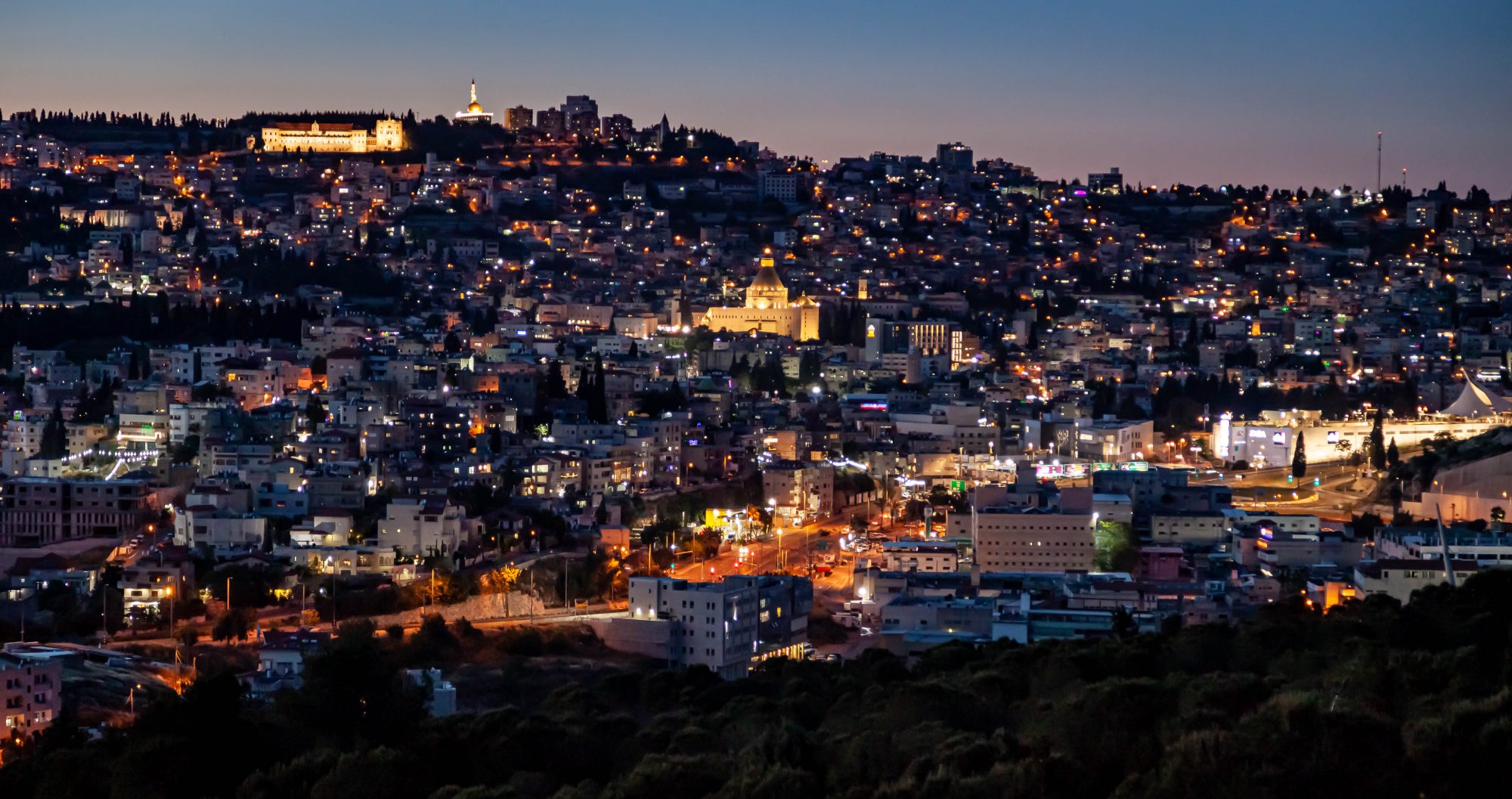
Modern-day Nazareth bares little resemblance to the small country village of Jesus's time. Today Nazareth is the largest Arab town in fully Israeli territory.
Yet the biggest celebration among Christians revolves around something no mere man could ever accomplish. Only a God-man, only the God-Man Jesus could offer himself as a sinless sacrifice for the sins of the world, which He did in a physical place at a real point in history.
I explored some of the sites of Jesus’ life and ministry and the modern life happening around them. Several places like the Sea of Galilee are undisputed locations of Jesus’ life. Other sites are reliable places from church lore. The authenticity of yet other sites is just a mystery. Either way, walk with me through spaces once occupied by Jesus and His disciples and open your mind to the reality of Jesus’ physical life and ministry. How does this reality change our perspective, our ministry and our eagerness to share our message of hope?
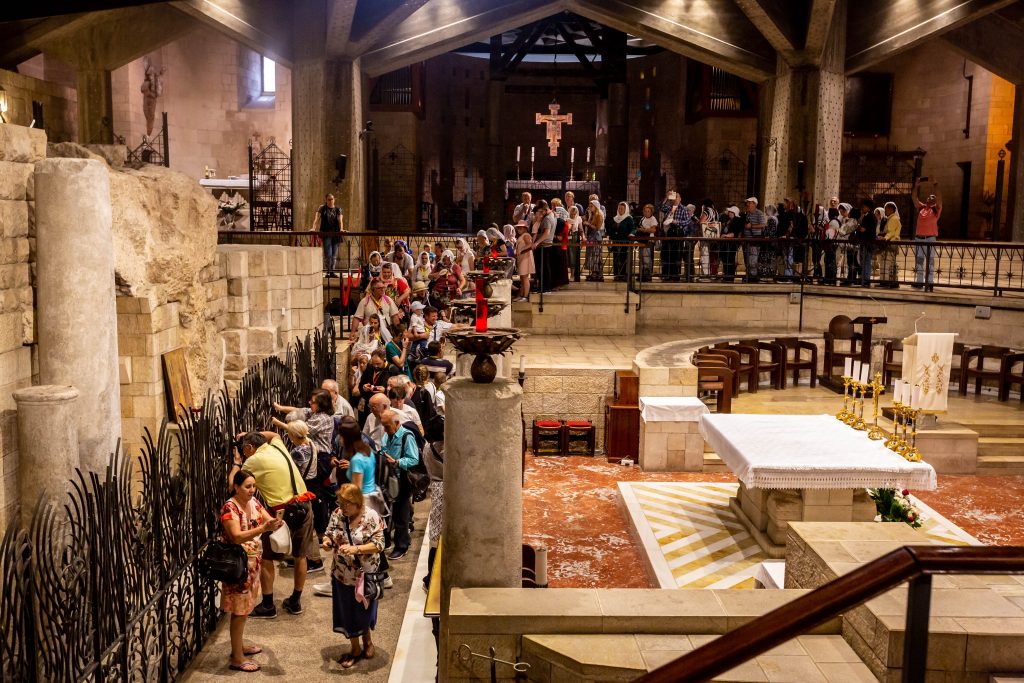
Pilgrims line up to view the spot believed to be where the angel visited Mary to announce her coming son, in the Church of the Annunciation in Nazareth, Israel, the largest Christian church in all of the Middle East.
Where Mary Heard the News: Church of the Annunciation in Nazareth
One ordinary day, an angel visited a young girl and made an announcement to her that would change the world. The angel Gabriel told Mary she would conceive by the Holy Spirit and give birth to a son who would be called the Son of the Most High (Luke 2:26-35).
The Basilica of the Annunciation in Nazareth, Israel, is the largest church in the Middle East and is built over the traditional location of Mary’s house. As early as the fourth century, Christian pilgrims to Nazareth mentioned the house where Gabriel visited Mary. Multiple churches have been built on top of this location over the centuries. A visit to the modern church offers a view into a simple stone recess many believe to be the original cave-house of Gabriel’s announcement.
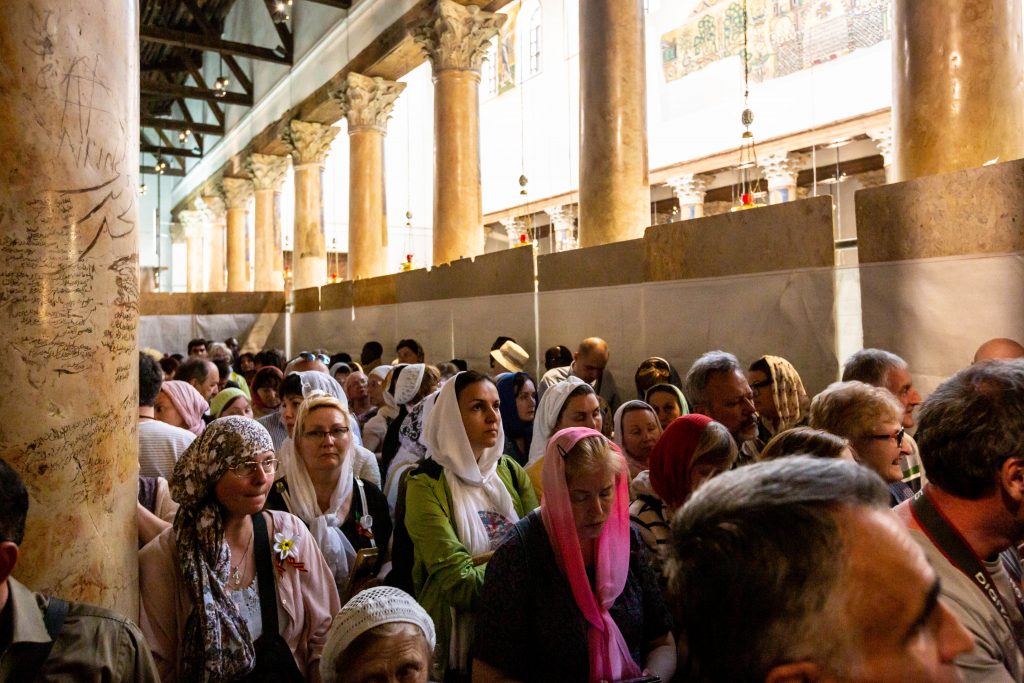
Christian pilgrims wait to enter the Church of the Nativity, which was built over the place where Christ is said to have been born.
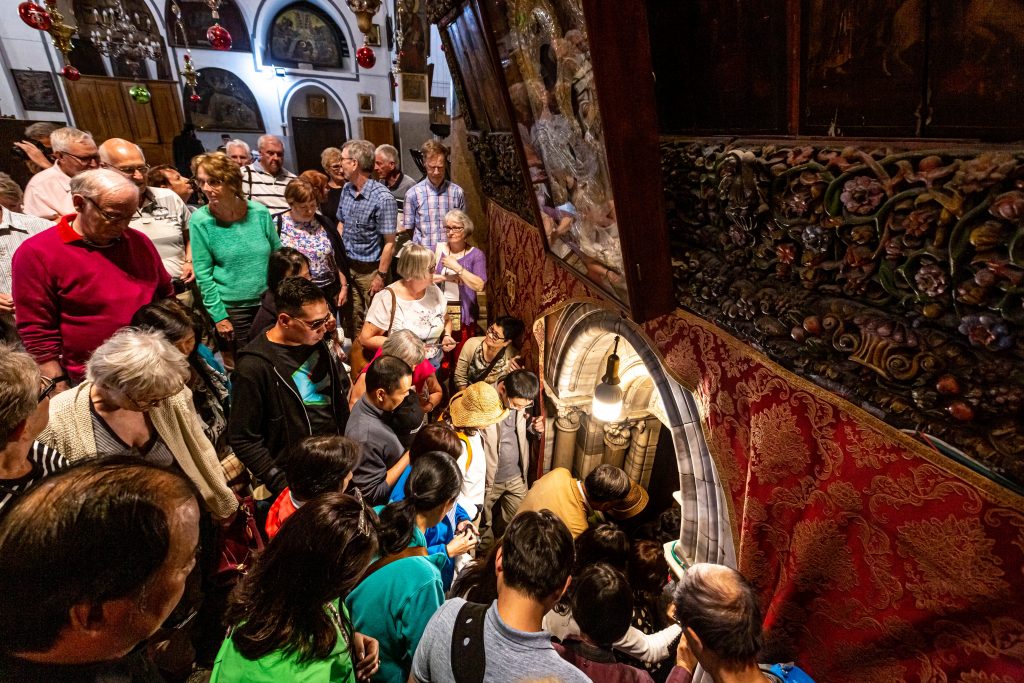
A mass of Christian pilgrims waits to enter the grotto where Jesus is said to have been born, beneath the Church of the Nativity in Bethlehem, Israel.
Where Jesus Entered the World: Church of the Nativity in Bethlehem
When the Roman emperor ordered that citizens of the empire be registered, Mary and Joseph traveled from Nazareth to Joseph’s hometown, Bethlehem. It was not an easy trip. On today’s roads, it takes at least 32 hours to walk from Nazareth to Bethlehem. There, among the lowing cattle, the promised Messiah uttered His first cries.
Modern-day Bethlehem lies in the Palestinian-controlled West Bank. Although Israeli citizens are banned from entering Bethlehem, tourists are welcome. Palestine acknowledges the sacred history that beckons pilgrims from around the world and keeps the city safe and open to economy-boosting tourism.
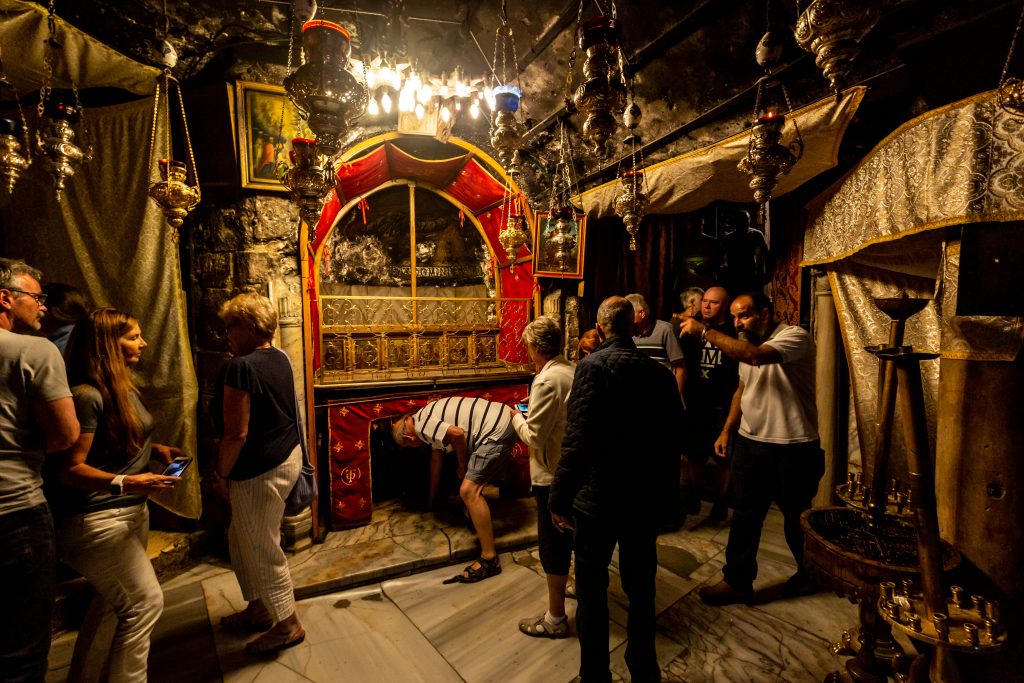
Pilgrims look inside the grotto beneath the Church of the Nativity in Bethlehem, Israel, where it is believed Jesus was born.
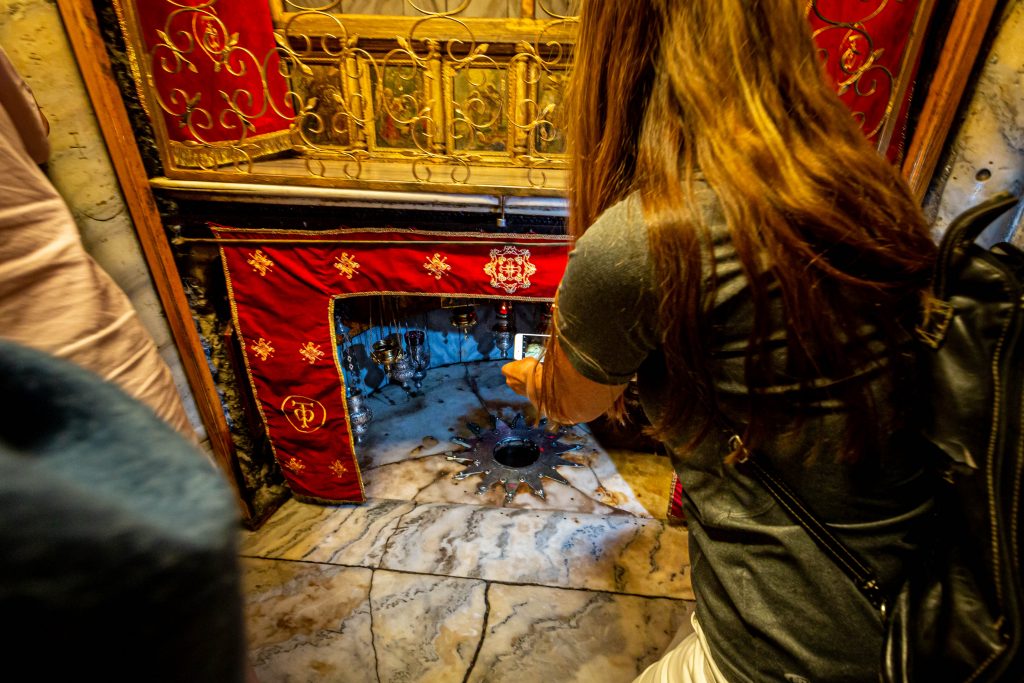
Inside the grotto beneath the Church of the Nativity in Bethlehem, Israel, is a silver star that marks where it is believed that Jesus’ manger stood.
The Church of the Nativity sits over a cave that, since the second century, Christians have believed to be the location of Jesus’ birth. The Roman Emperor Hadrian was so bothered by Christians gathering there that he constructed over it a pagan worship building, which stood until Constantine’s mother, Helena, built a Christian church in the fourth century. The current church is largely a Crusader church from the sixteenth century, but it retains elements from its former structures. It is the oldest church in the Holy Land.
Tourists can enter the church only with a hired guide, who leads them through the church and into a bottlenecked crowd clamoring to descend a few stairs and see a marked location believed to be where Jesus’ manger sat.
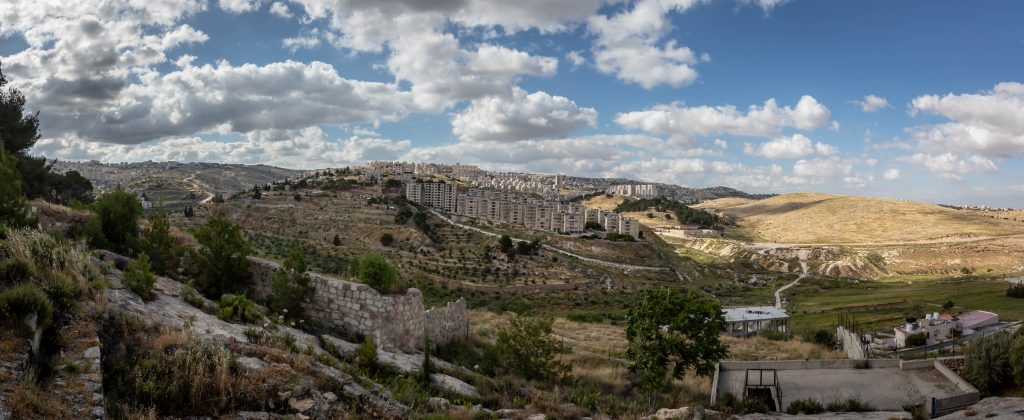
This field outside of Bethlehem, Israel, is believed to be the place where the heavenly hosts appeared to the group of shepherds as they were watching over their flocks, to announce the birth of Jesus.
Where the World First Heard: Shepherd’s Field in Bethlehem
When the glory of the Lord shattered the darkness of a nearby field, the shepherds camping there were terrified. But the good news they heard turned their fear into joy. They hurried to see the baby and report what they witnessed.
Just a short drive from the Church of the Nativity, an unobtrusive field sits outside the city. Ancient caves still exist near the field and would have been ready shelters for shepherds. This is the field traditionally associated with the heavenly proclamation. Tourists visit a chapel on the site and sing year-round Christmas carols: “Yet in thy dark streets shineth the everlasting Light. . . .”
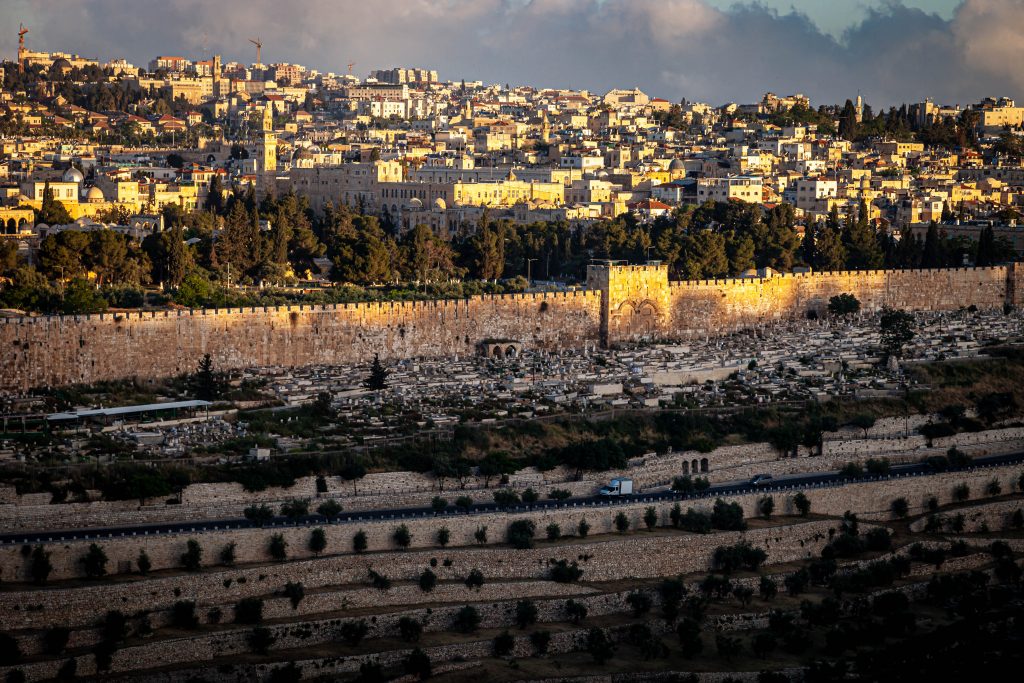
The Eastern Gate is not the original from Jesus’ time, but this gate stands on or near the location of the one Nehemiah built. The original gate provided the nearest entrance to the Temple and is likely the gate Mary and Joseph used when they brought baby Jesus to be dedicated. According to Jewish tradition, this gate is also believed to be where Christ will enter the Holy City during His triumphant return.
Where Jesus Was Dedicated: the Temple in Jerusalem
After Jesus was circumcised, Mary and Joseph brought him to Jerusalem to fulfill the requirements of the law and to dedicate Him to the Lord (Luke 2:23). They would have likely brought Him up to the temple complex by way of the East Gate, which offered the most direct access to the temple. Passing through the gate, they would have quickly arrived in the temple courtyard and met an old man named Simeon, who took the baby and praised God with holy wonder saying, “My eyes have seen your salvation” (Luke 2:30).
Today’s Eastern Gate is not original from the time of Christ, but it sits over the same vicinity as the gate Nehemiah built. The Muslims sealed the Eastern Gate in the sixteenth century, fearful of Old Testament prophecies and believing that a sealed Eastern Gate might somehow deter the Jewish Messiah from returning to reign. Here at the steps of the gate, Christians still gather, singing worship songs and reflecting on the Savior who entered the temple.
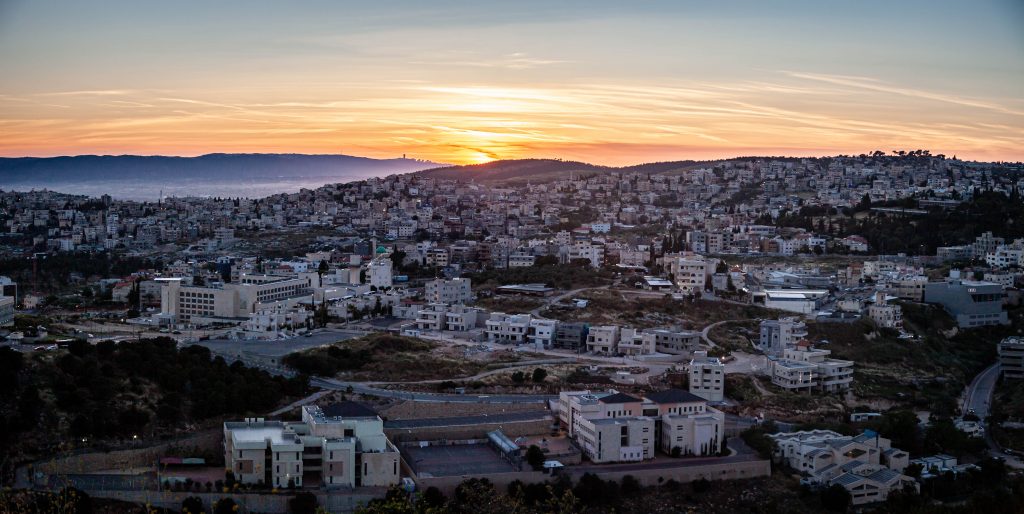
Modern-day Nazareth bares little resemblance to the small country village of Jesus’ time. Today Nazareth is the largest Arab town in fully Israeli territory.
Where Jesus Grew Up: Nazareth
Back in Nazareth, Jesus, the boy, grew in wisdom and knowledge. Currently, Nazareth is home to about 80,000 people, but the village of Jesus’ boyhood was only 400 to 500 people. Here, He probably learned building skills—carpentry and stonework—from His father.
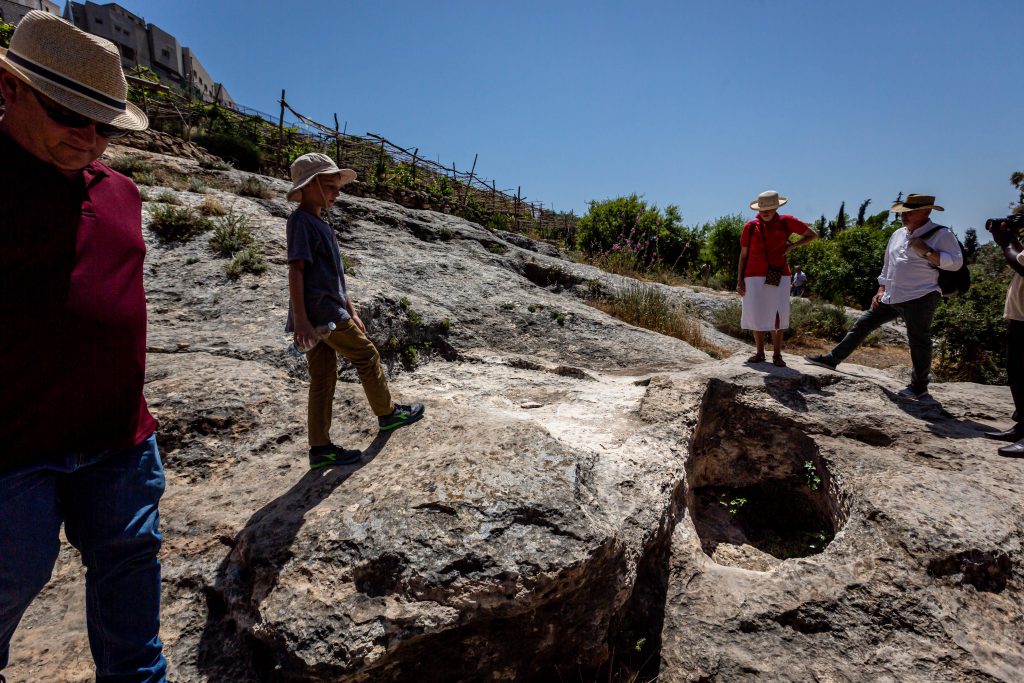
A first-century wine press still exists in Nazareth and likely was a place Jesus knew and visited. It may have been in His mind when He later told a parable saying, “A man planted a vineyard and put a fence around it and dug out a pit for a winepress and built a tower” (Mark 12:1).
Modern Nazareth is a Palestinian town in Israel and is about 20% Arab Christian. A first-century wine press still exists in Nazareth and likely was a place Jesus knew and visited. It may have been in his mind when he later told a parable saying, “A man planted a vineyard and put a fence around it and dug out a pit for a winepress and built a tower” (Mark 12:1).
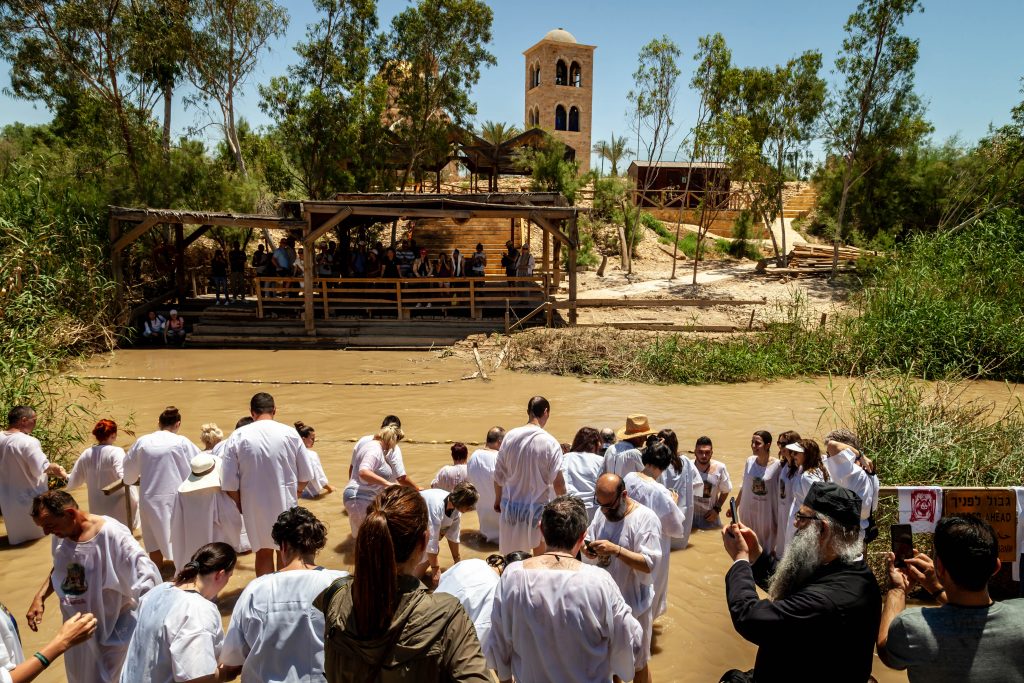
Orthodox Christians enter the waters of the Jordan River near the Qasr al Yahud crossing. Across the river is the Jordanian border.
Where Jesus Was Baptized: Jordan River
John the Baptist baptized repentant sinners in Bethany across the Jordan. It was here John also baptized Jesus and proclaimed, “I have seen and have borne witness that this is the Son of God” (John 1:34).
The point of the Jordan River traditionally associated with Jesus’ baptism is narrow and muddy. On one side of the river is the Palestinian-controlled West Bank, and on the other side is the country of Jordan. First-century pilgrims sketched crosses on sandstone walls that still stand nearby. Today, visitors don baptismal robes and enter the muddy water to be re-baptized.
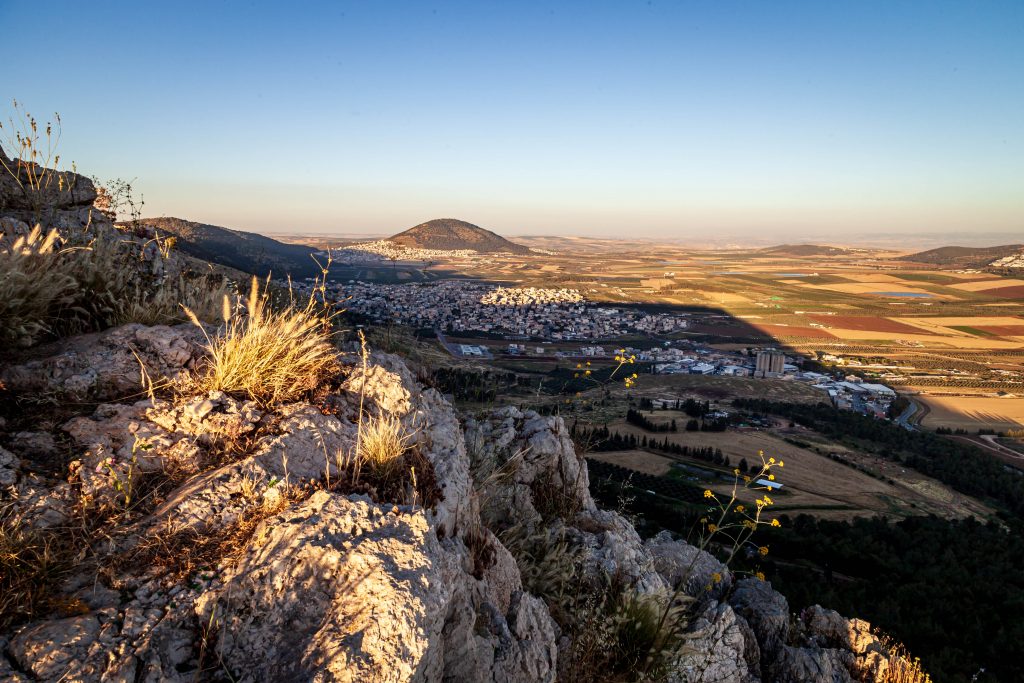
Mt. Precipice is the high place outside of Nazareth believed to be the site from which the Jewish leaders tried to throw Jesus after He revealed His divinity.
Where Jesus Encountered Rejection: Nazareth
Shortly after Jesus began His ministry in Galilee, He returned to His hometown of Nazareth and entered the synagogue on the Sabbath to read Scripture as He always did. He unrolled the scroll and, after reading about the Messiah from Isaiah, said, “Today this Scripture has been fulfilled in your hearing” (Luke 4:21).
In first-century Israel, there were two reasons for executing people. The first was a criminal offense, paid for on a cross. The second was for a religious offense. If someone claimed to be a prophet, he was tied up and pushed head-first from a cliff. The townspeople who saw Jesus grow up were so enraged by His claim to be the Messiah, they drove Him to a cliff to cast Him off. “But he passed right through the crowd and went on his way” (Luke 4:30).
Precipice Hill in Nazareth is the traditional location of this violent mob’s execution attempt. One short drive outside the city, and you’ve got a stunning vista of Nazareth from the top of this cliff. Locals and tourists alike come up here for a quiet getaway from the city and a stunning overlook of the city.
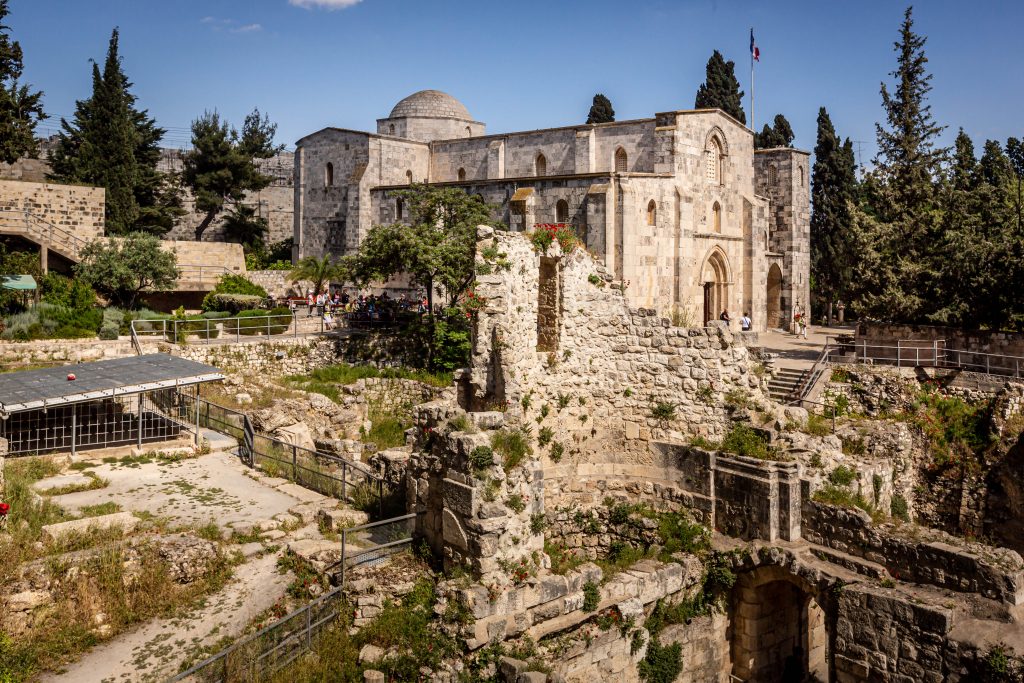
Church of St. Anne in the Muslim Quarter of Jerusalem’s Old City is one of the best-preserved Crusader constructions in Jerusalem. The present church, a Crusader basilica from AD 1140, was built over a previous church constructed around AD 450 on the supposed site of Mary’s parents’ house. Unlike most other Christian structures, the Crusader basilica escaped destruction during the Muslim Conquest of 1189.
Where Jesus Performed Miracles: Pools of Bethesda
Early in Jesus’ ministry, He traveled to Jerusalem for a Jewish festival. The Bethesda Pools were a short walk from the Sheep’s Gate (the modern-day “Lion’s Gate”) and on the way to the temple. The first pool was built to hold runoff water hundreds of years before Christ, and a second pool was added later. People collected water here for daily living and washed animals to be used for temple sacrifice. Those with disabilities waited for a supernatural experience of healing in the waters.
One man waited, and waited, and waited. He waited for thirty-eight years until the day Jesus the Messiah looked down at him and asked, “Do you want to get well?” That day, the man stopped waiting.
The pool ruins are deep and extensive, easily bringing to mind the scene that unfolded in John 5. Adjacent to the pools is Saint Anne’s Church, a Crusader church built over the traditional site believed to be the home of Mary’s parents, Joachim and Anne.
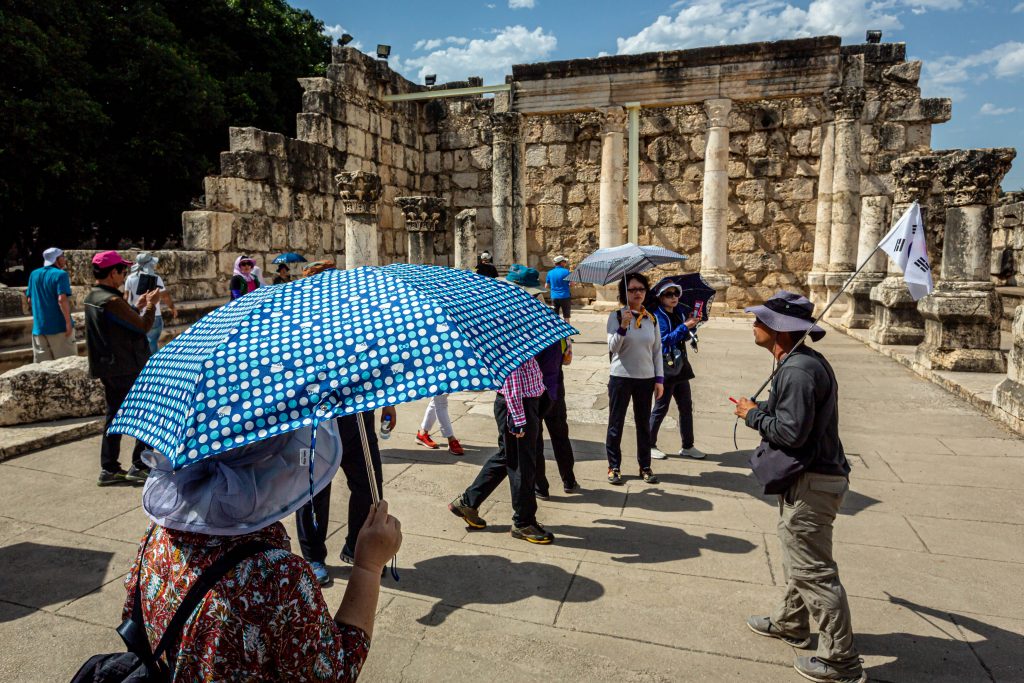
South Koreans visit the archeological site of the ancient village of Capernaum on the shores of the Sea of Galilee in Israel.
Where Jesus Ministered around Galilee: Capernaum, the Sea and Magdala
For a time, Jesus lived in the town of Capernaum on the coast of the Sea of Galilee (Matt. 4:13). Here in Capernaum, He taught with authority (Luke 31:32), healed the centurion’s servant and Peter’s mother-in-law (Matt. 8:5, 14), healed many demon-possessed people including a man in the synagogue (Matt. 8:16; Mark 1:21), and healed the paralytic let down through the roof (Mark 2:1-12).
Despite all these signs, the people of Capernaum received a stinging rebuke from Jesus for their stubborn unbelief (Matt. 11:23).
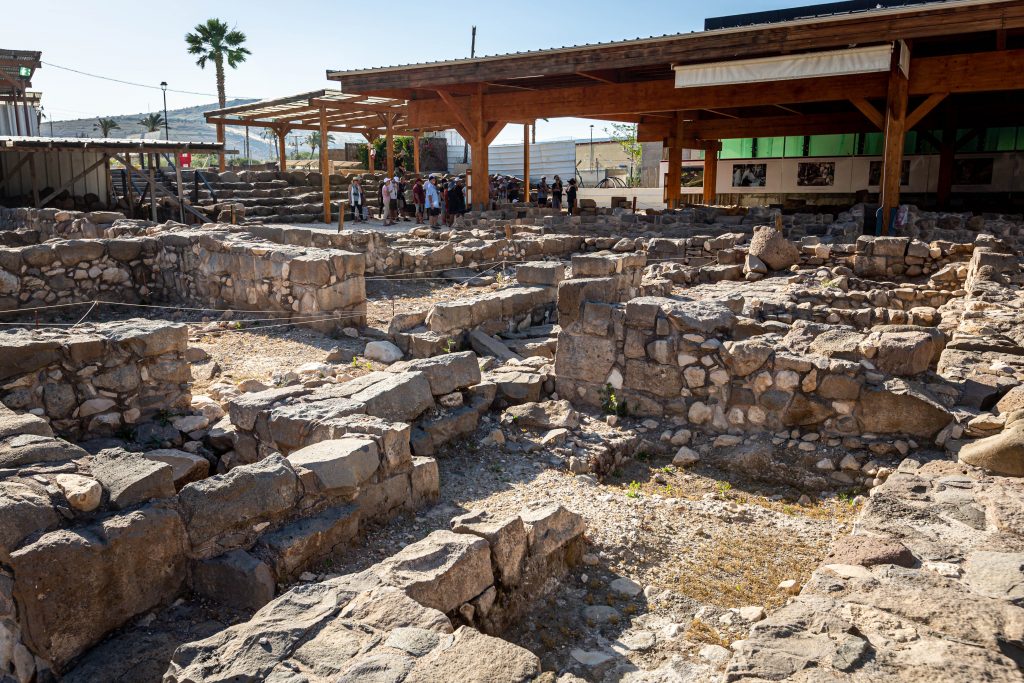
In the Galilean village of Magdala, the remains of a first-century Jewish village, complete with a synagogue, were discovered during the construction of a hotel.
Extensive remains from the first century have been discovered, including black basalt stone walls from first-century homes and remains from a fourth- or fifth-century synagogue believed to be built upon the ruins of the same synagogue where Jesus taught.
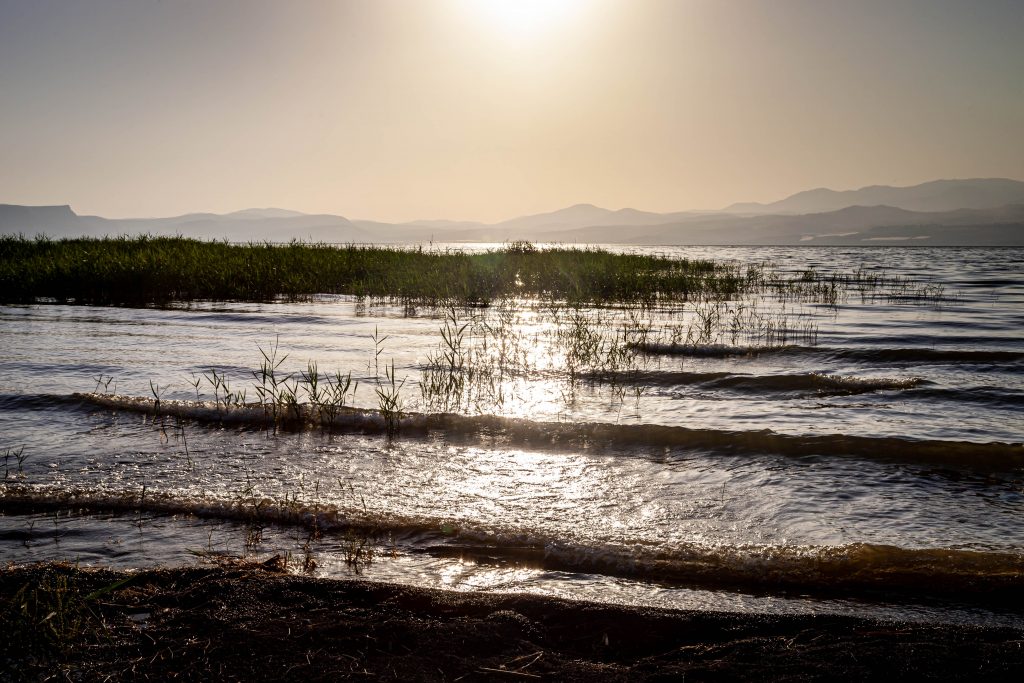
No other place in the Holy Land has a more direct and unmistakable link to Jesus than the shores of the Galilean Sea. While all the other locations throughout the Holy Land are places “believed” to be the site where Jesus did this or that, the Sea of Galilee is a sure thing. This is the sea where Jesus walked on water, where He sought refuge from the surging crowds, and where He appeared to the disciples after His resurrection.
Capernaum is a seaside town directly on the coast of the Sea of Galilee. Much of Jesus’ ministry happened on and around this body of water. Jesus appeared here to His disciples when they were sailing across the sea to Capernaum. This is the sea where Peter took a faltering step toward Jesus—on the water. This is where the waves whipped up around the disciples’ boat and frightened them into waking Jesus during the storm.
The sea is seven-and-a-half miles long and thirteen miles wide at its widest point. It only takes about one hour to drive around its thirty-seven miles of shoreline. Over the years the country has carried out various water projects related to the Sea, which is currently a controlled reservoir rather than a natural lake. The coast of the sea is largely undeveloped, with an occasional resort or town like Tiberius, where you can stop for a fish meal on a waterfront boardwalk.
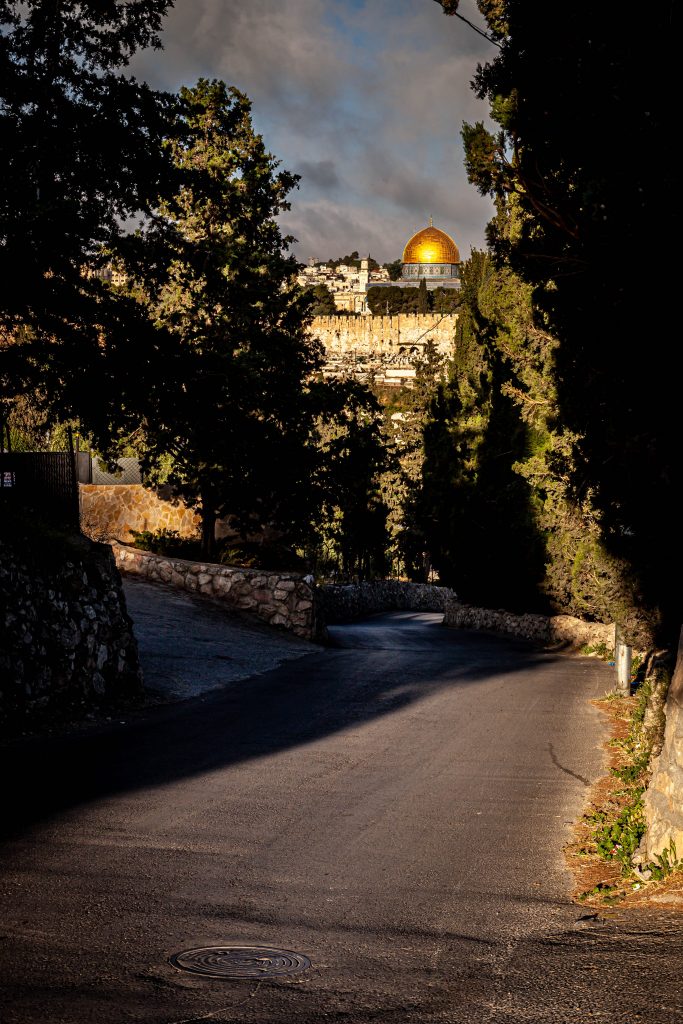
This modern road that leads from the Mount of Olives down the Kidron Valley toward the Old CIty of Jerusalem covers the ancient path that existed during Jesus’ time. It is on this palm branch-covered path that Jesus rode into Jerusalem to shouts of “Hosanna! He who comes in the name of the Lord is the blessed One!” Mark 11:4-10.
Where Jesus Rode a Donkey: Entrance into Jerusalem
The time came for Jesus to fulfill centuries of prophecies, submit to His Father, and enter the suffering laid out for Him. He had forewarned His disciples about what would happen. Now He sat on a donkey and rode into Jerusalem from the Mount of Olives.
The crowd shouted, Hosanna! which means “Save us!” A paved modern road has been built over part of the path Jesus might have ridden. The donkey carried the humble King slowly down the hill, across the Kidron Valley, and up again toward the city where the King would suffer and die.
“When he entered Jerusalem, the whole city was shaken” (Matt. 21:10).
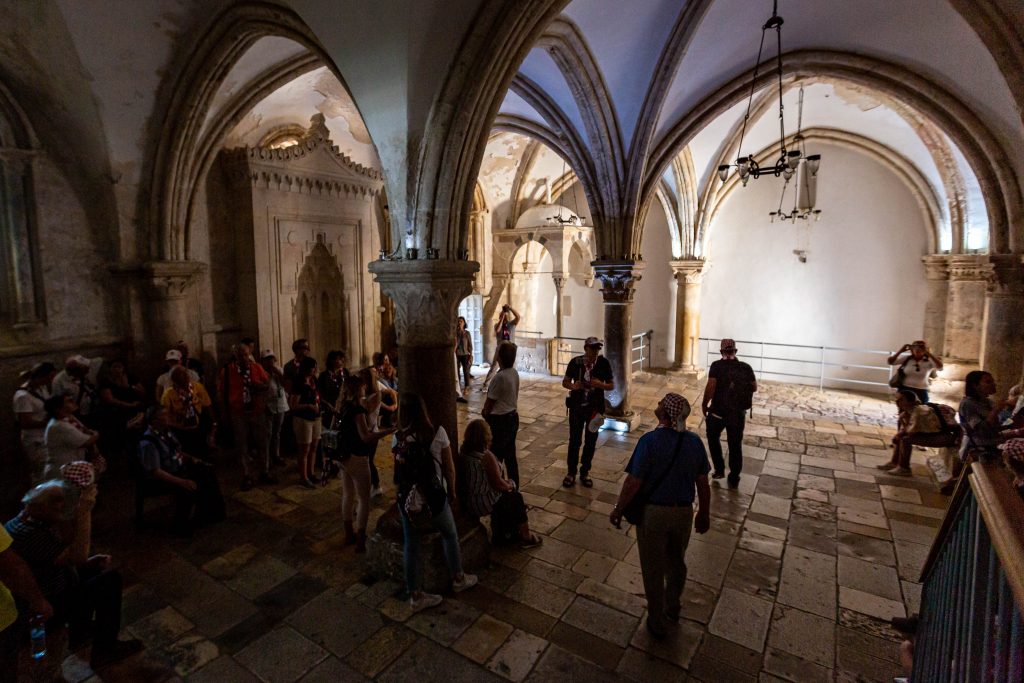
Christian pilgrims visit the supposed Upper Room, where Jesus met with His disciples to break bread before His crucifixion.
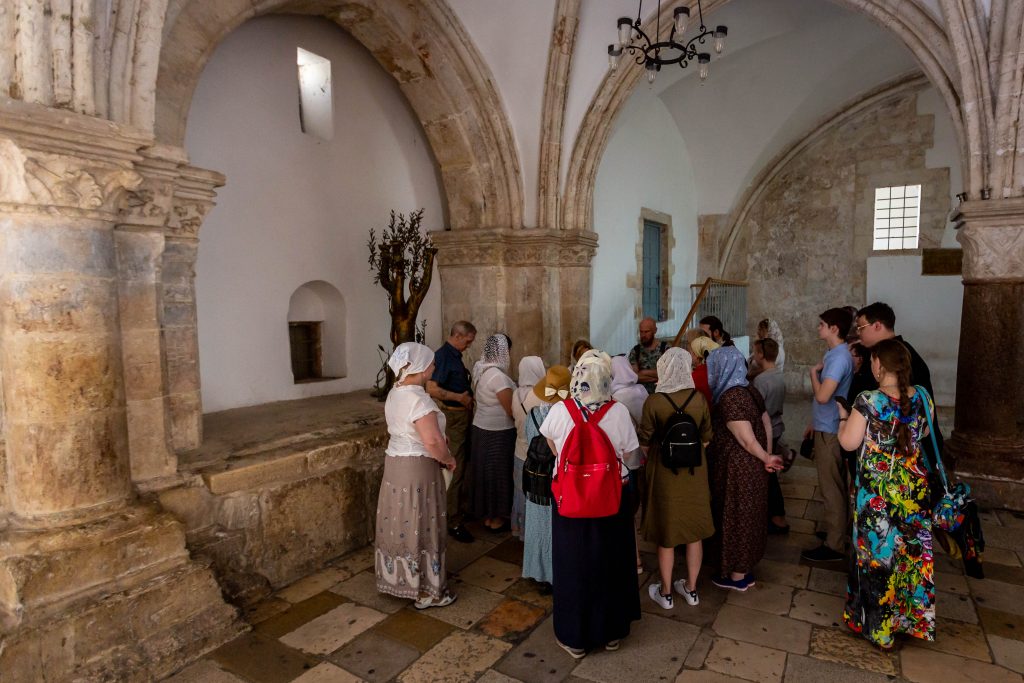
Where Jesus Observed the Passover: the Upper Room
It was a borrowed room from an unnamed man, but its four walls witnessed the Passover Lamb Himself celebrating the Jewish feast for the last time until the Kingdom of God comes. In this room, Jesus inaugurated the Lord’s Supper and told His disciples that His blood would be shed for the forgiveness of sins (Matt. 26:28). In this room, the King of Kings knelt like a slave and washed the dust-crusted toes of His disciples, even the disciple who would betray Him.
The Upper Room in Jerusalem is not the original structure of Jesus’ last supper. But it does sit on top of the location widely believed to be the original location of not only the Last Supper, but also where Jesus appeared to the disciples after His resurrection, and where the events of Pentecost occurred.
Several churches have been built on this spot over the centuries. The current room is a fourteenth-century Crusader-church restoration with Islamic elements added later by the Turks, who converted it into a mosque in the sixteenth century.
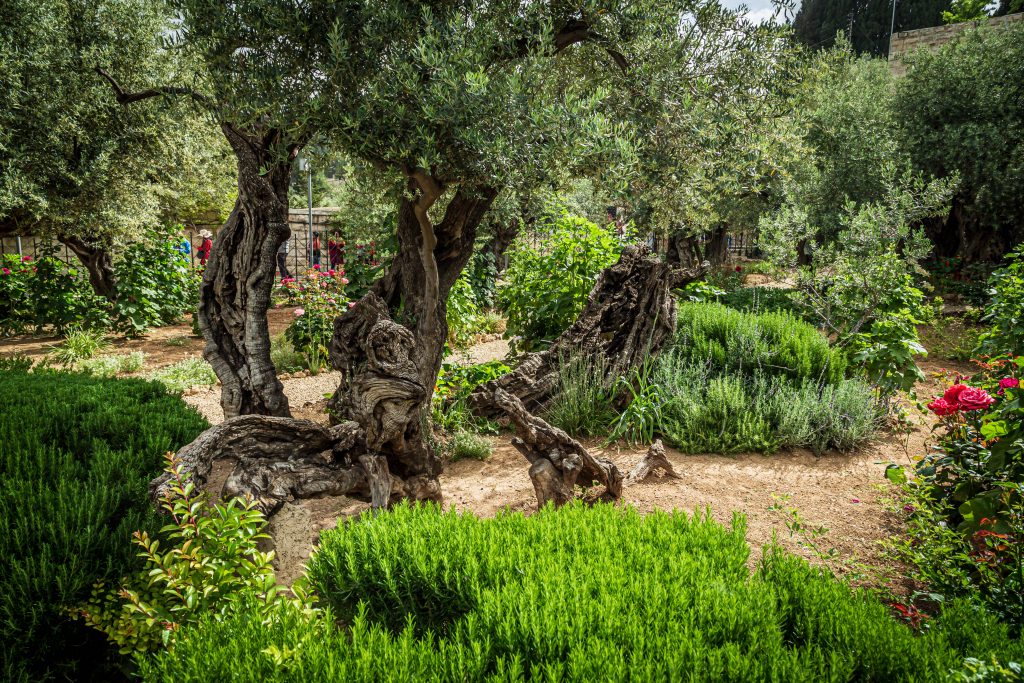
The Garden of Gethsemane was host to many scenes of the Gospels. The word Gethsemane is Hebrew for “pressing,” and this location was the place of pressing olives for oil and also for pressing Jesus for the believer’s sake.
Where Jesus Sweat Blood: Garden of Gethsemane
Looking out from modern-day Jerusalem, the land dips deeply into a valley before rising again to the Mount of Olives. This is the Kidron Valley, the same Kidron Valley Jesus crossed when He left the Upper Room and walked to a garden called Gethsemane, literally meaning “pressing” in Hebrew because of the nearby olive press (John 18:1). Here, among the olive trees, Jesus and His disciples spent time together. And here, on the night He was betrayed, Jesus poured out His soul to His Father. The Messiah was in such agony—pressed hard in the garden of pressing—His sweat dropped like blood.
The Garden of Gethsemane today is still an olive grove, home to centuries-old olive trees. One end has been built up with sidewalks, flowers and a church. The other end is wild and mostly untended. Ancient caves are a stone’s throw away from the grove (Luke 22:41). These caves could be where the disciples took shelter from the cold and dozed off that night.
As an angry mob made its way through the valley to the garden, Jesus submitted to His Father, praying, “Not my will, but yours be done.”
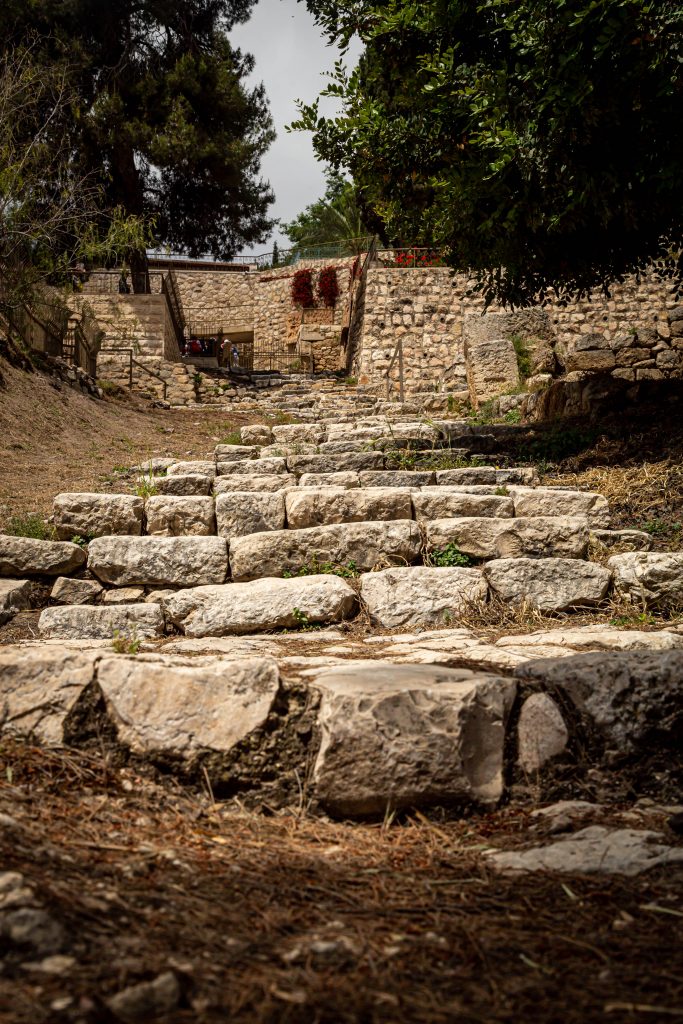
It is likely that Jesus walked on these first-century steps that lead from the Mount of Olives to Jerusalem, as the Jewish religious leaders led him from the Garden of Gethsemene to the home of Ciaphas, the high priest.
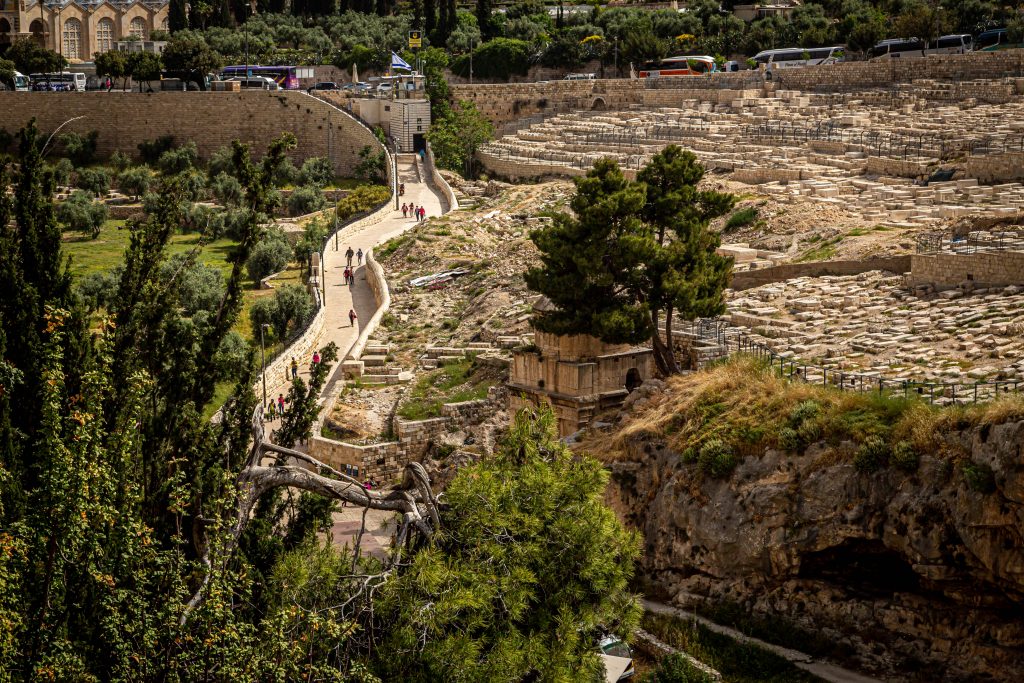
This path runs directly from the Garden of Gethsemane through the Kidron to old Jerusalem. It is believed that this is the path that Jesus’ captors took on their way to Ciaphas’s palace.
Where Jesus Met Caiaphas: House of Caiaphas
The mob carrying swords and clubs led Jesus out of the garden, through the Kidron Valley, and up a staircase to the house of Caiaphas, the high priest. The religious leaders were gathered and waiting, eager for a chance to finally put Him to death. Peter followed the mob and lingered quietly in Caiaphas’s courtyard, where he denied his Lord three times.
The worn stone steps from the valley up to Caiaphas’s house are original from the first century and the same stones Jesus descended down to the garden and up again after His arrest.
Beneath the floors of the Church of Saint Peter in Gallicantu, there is an ancient prison area where it is believed that Jesus was held the first night He was taken to Caiaphas’s house. It is believed that Jesus was let down through this small hole into the prison.
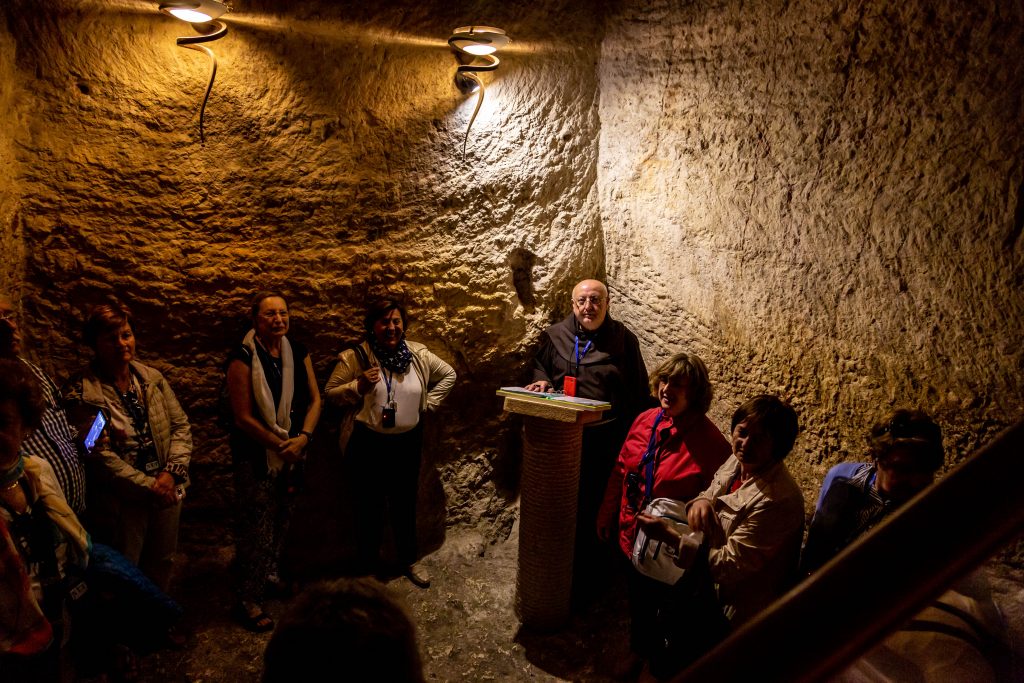
A catholic priest leads a tour group through the prison found beneath the floors of the Church of Saint Peter in Gallicantu. It is believed that Jesus was held here the first night He was taken to the home of Caiaphas, the high priest.
Where Jesus Was Imprisoned: Dungeon at Caiaphas’s House
Here at Caiaphas’s house, Jesus was charged with blasphemy and held overnight.
The Church of St. Peter in Gallicantu is built over the site traditionally believed to be the house of the high priest. First-century caves and cisterns still exist under the house. Tradition claims one of these segments would have been used as a prison. Many believe one small room, the Sacred Pit, is where Jesus was held. It was inaccessible by foot, so He would have been let down with ropes through a shaft in the ceiling.
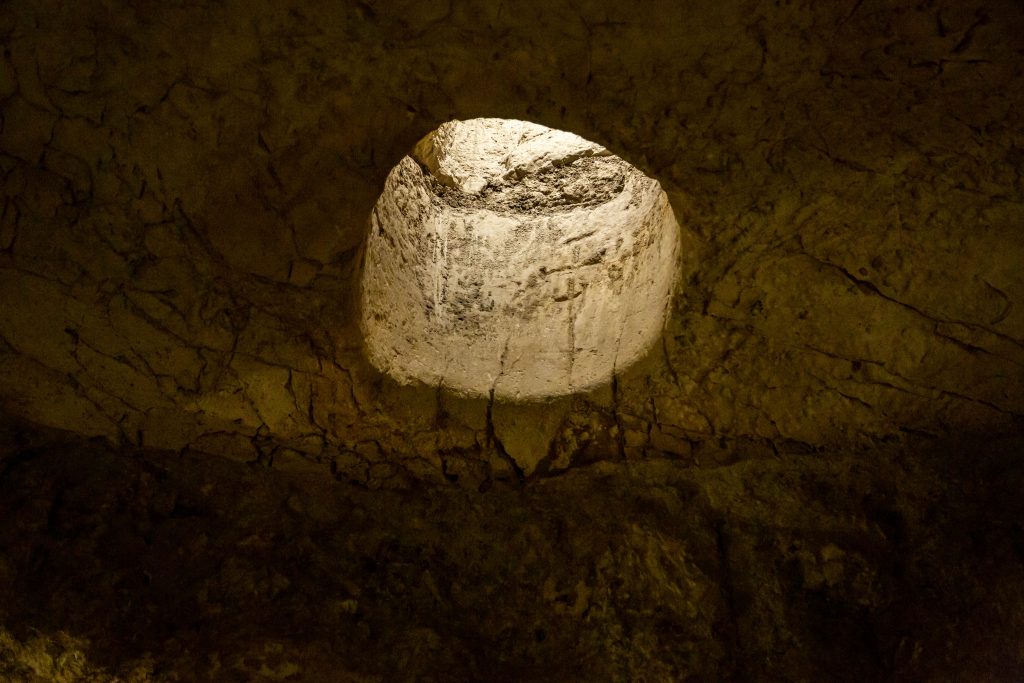
It is believed that Jesus was let down through this small hole into the prison beneath the floors of the Church of Saint Peter in Gallicantu.
Many read Psalm 88 and believe Jesus fulfilled the Psalmist’s words in the blackness of that night: “You have put me in the depth of the pit, in the regions dark and deep. . . . You have caused my beloved and my friend to shun me; my companions have become darkness” (Psalm 88:6,18).
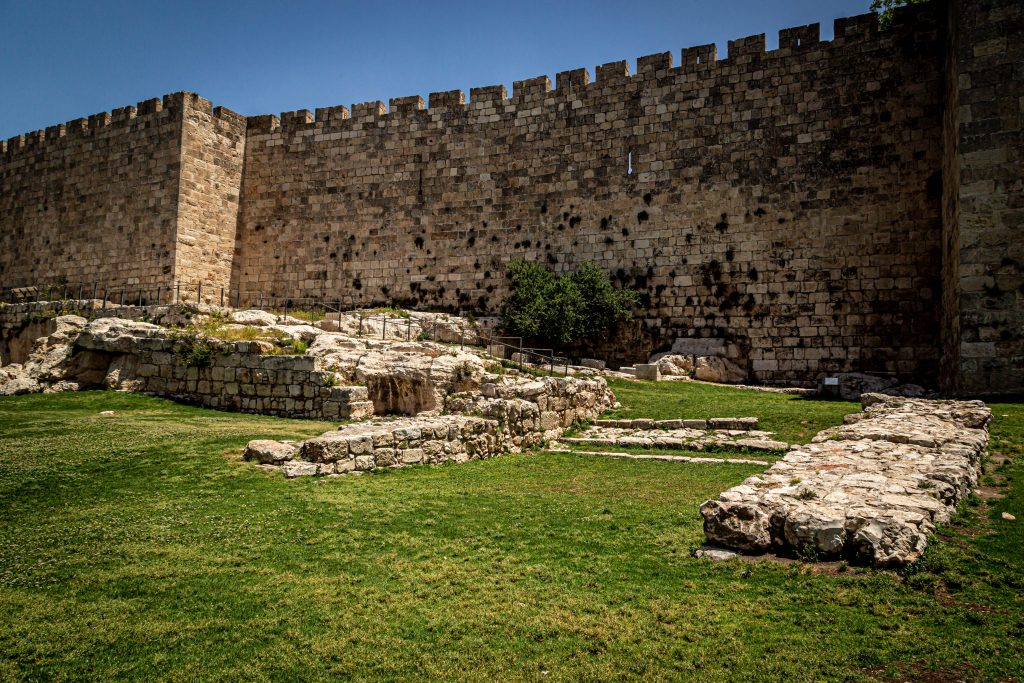
This area outside the current wall of Jerusalem’s Old City is believed to be the site where Jesus stood before Herod.
Where Jesus Stood Trial: Herod’s House
Early in the morning, Jesus was taken from Caiaphas’s house to Pilate, the Roman governor. The angry Jewish leaders refused to enter the house because they wanted to keep themselves ceremonially clean for the Passover. So Pilate came out. Jesus was sent to Herod and back again to Pilate. Finally, the crowd got their way. Jesus was tried outside the walls in a place called the Stone Pavement (John 19:13).
Many believe Pilate was staying in Herod’s palace. The location of Jesus’ trial is disputed, but some believe it to be at the southwest corner of Herod’s palace. Here, there used to be an outer gate and courtyard. The site today is largely overlooked by tourists. Grass blows in the wind as locals pass. Yet if this was indeed the space of Jesus’ trial, two thousand years ago it was filled with blood-curdling screams: “Crucify Him!”
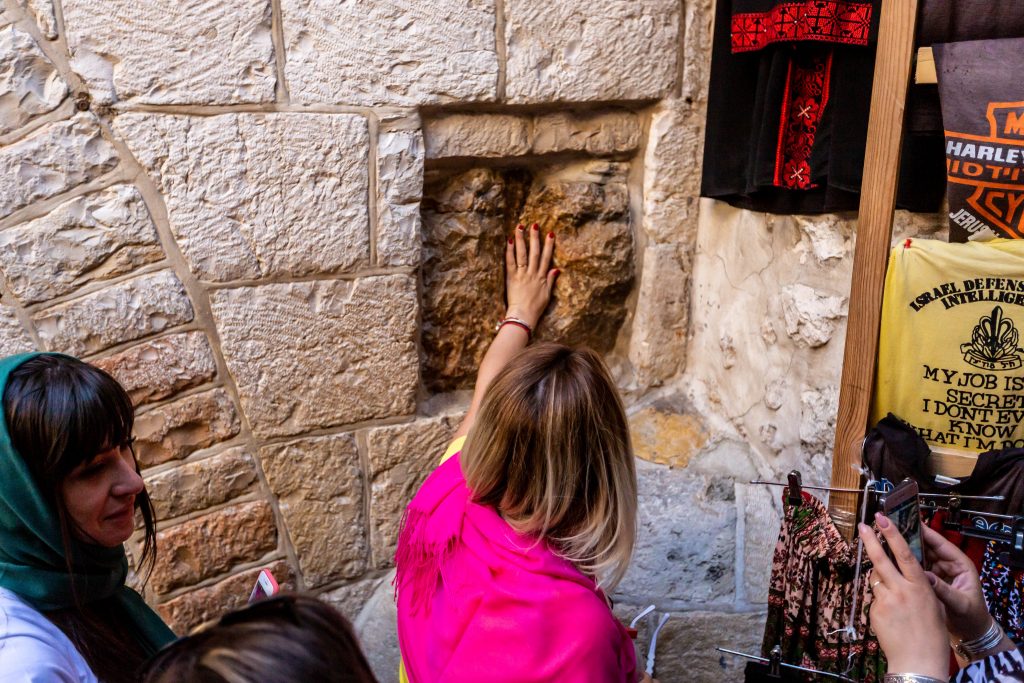
The Via Dolorosa is a path through Jerusalem’s Old City that attempts to trace the journey Jesus might have taken on his way to the cross. At this stop, Station 5, it is believed that Simeon the Cyrene carried the cross for Jesus.
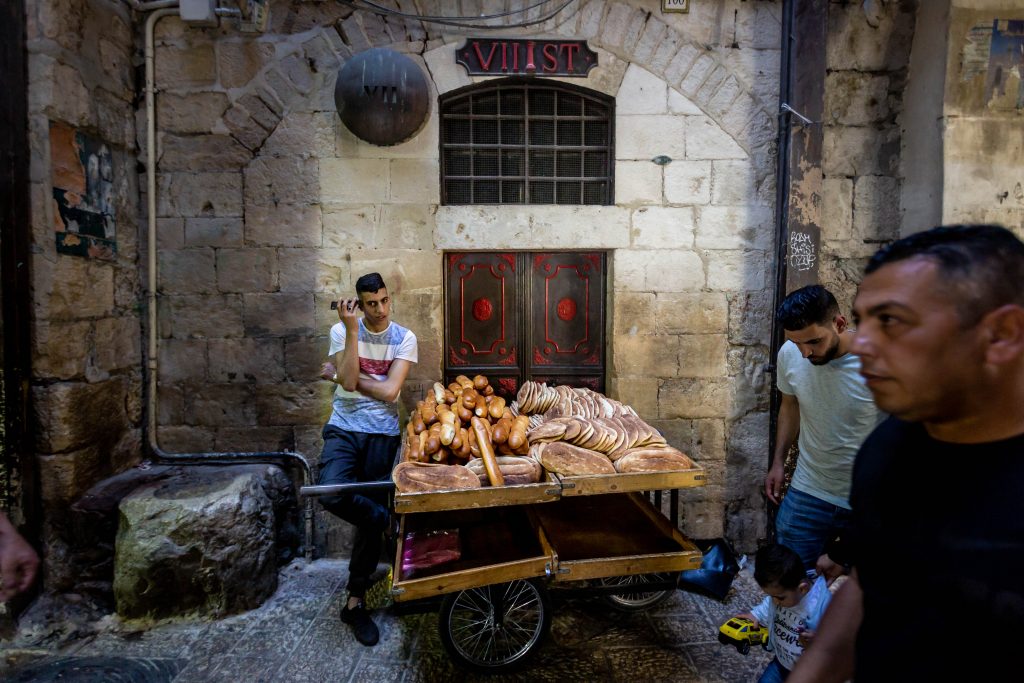
Here at Station 7 of the Via Dolorosa, it is believed that Jesus fell for the second time on His way to the cross.
Where Jesus Carried His Cross: Via Dolorosa
The road from Jesus’ trial to the place of His crucifixion is traditionally called Via Dolorosa, “Way of Suffering.” Scriptures give us only a couple of glimpses of what happened on this road. A large crowd of women followed Jesus, weeping as they went. A foreigner named Simon was tasked with carrying Jesus’ cross. It was truly a way of sorrow—Isaiah’s Suffering Servant was being stricken.
Today fourteen stations mark a defined route of the Via Dolorosa. Franciscan friars lead a weekly procession of pilgrims down the streets of old Jerusalem. Some of the stations commemorate events of tradition not recorded in Scripture, like a woman named Veronica wiping the face of Jesus. The authenticity of the entire route is also suspect. Even so, pilgrims find it meaningful to reflect on the passion of Christ as they walk through old Jerusalem toward Golgotha.
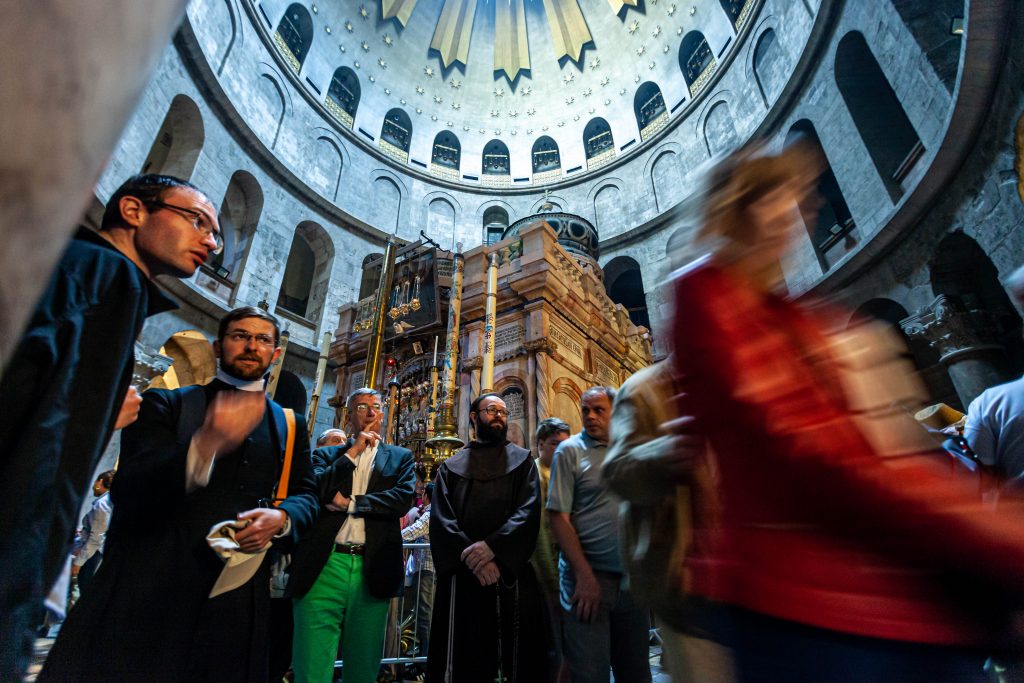
Church of the Holy Sepulchre in the Christian Quarter of Jerusalem’s Old City is centered on two main events—the site of Christ’s crucifixion and the site of Christ’s tomb. The word sepulchre means “tomb,” “catacomb,” or “crypt.” This smaller chapel inside the larger church dome is the place believed to be the tomb of Joseph of Arimathea where Christ was buried. Today pilgrims from around the world wait in a long line for the chance to briefly step into the chapel and view the temporary resting place of the Messiah.
Where Jesus Died: Church of the Holy Sepulchre
“And when they came to the place that is called The Skull, there they crucified him” (Luke 23:33). Here, Jesus took the punishment for sin. He suffered amid common criminals. The pain intensified as He slowly suffocated. He cried out in agony because of the broken relationship between Him and His heavenly Father. The Lamb of God went to the cross as a willing sacrifice to make atonement for all who believe in Him.
The Church of the Holy Sepulchre in Jerusalem is the location of Christ’s death and resurrection according to the vast majority of Christendom. Underneath the church, first-century tombs can still be seen. Once a rock quarry, the area became a cemetery and a place of executions after the stones were no longer usable. In the second century, the Roman Emperor Hadrian built a pagan place of worship over the site to deter its many Christian pilgrims. In the fourth century, Emperor Constantine’s mother, Helena, replaced it with a church. Significant portions of the current church remain from an eleventh-century Crusader church.
The church is a large space of sensory overload. Six Christian groups—Roman Catholic, Greek Orthodox, Armenian, Syrian, Coptic and Ethiopian—manage separate places of worship within the church. One of the most significant areas is the upper balcony, with the traditional site of Christ’s crucifixion and a stone from Golgotha under the Greek Orthodox altar. Equally notable is the Edicule on the lower level, which marks the traditional place of Jesus’ tomb.
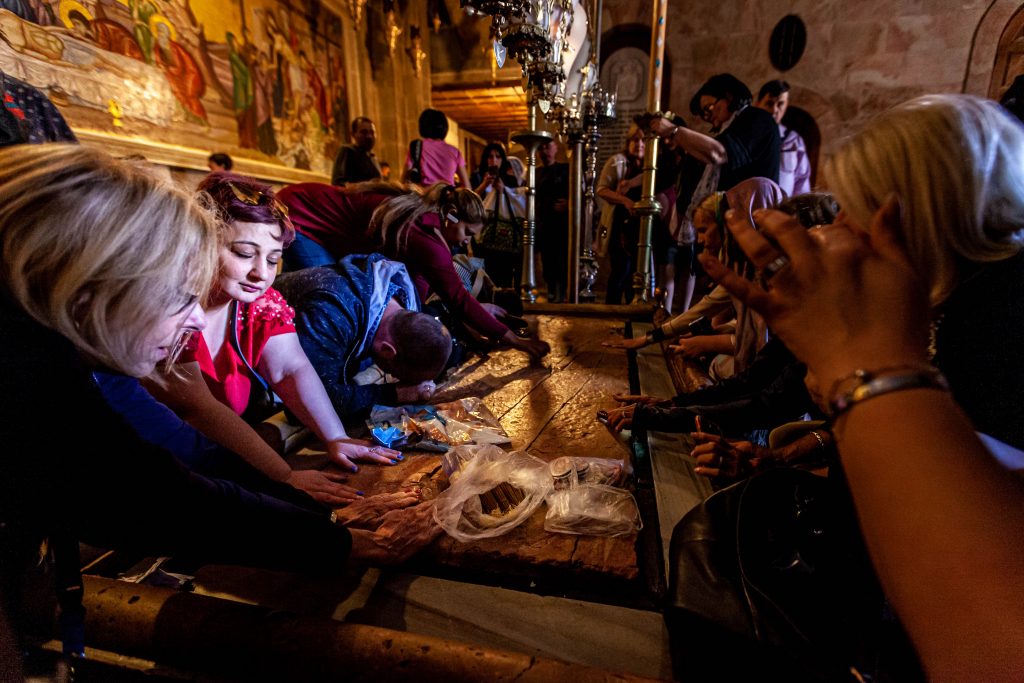
Pilgrims from around the world come to the Church of the Holy Sepulchre to worship and experience God. Here people touch and pray over the Stone of Anointing, a slab believed to be the place where Jesus’ body was laid after the crucifixion.
Visitors stream through the church from morning till night, many bringing religious articles and pieces of clothing for blessing. The Stone of Unction, also called the Stone of Anointing, is a stone said to be where Jesus was laid for anointing after His death. Even though its authenticity is questionable, the stone is meaningful to its many visitors who kiss it and pour and wipe oil with cloths brought from home.
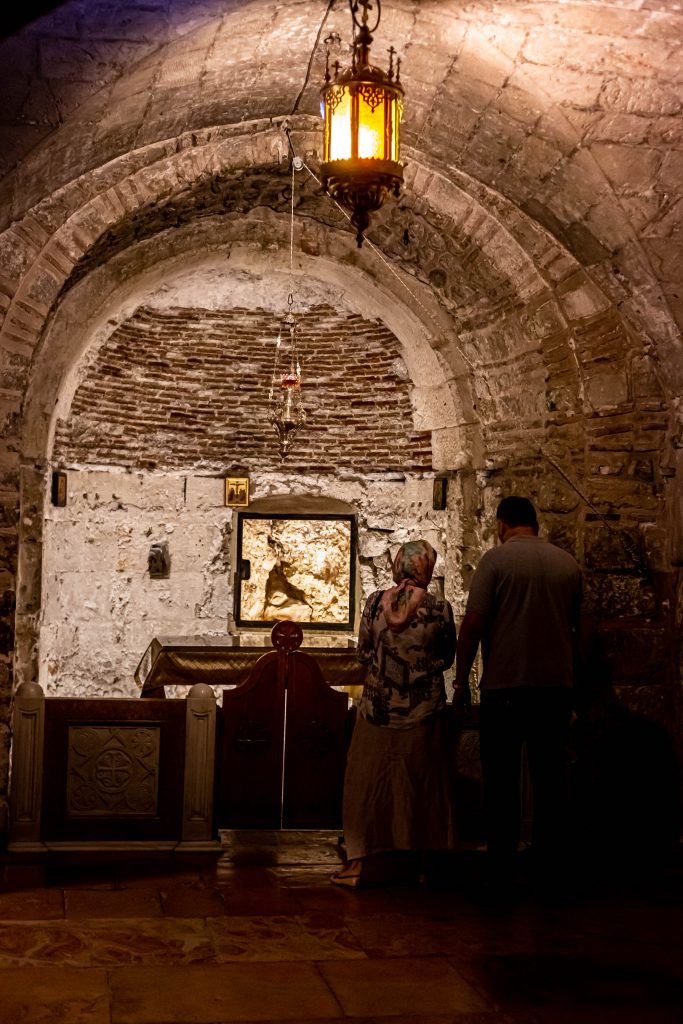
The lower level in the Church of the Sepulchre shows split rock from the first century. Some geologists believe this was a natural break in the rock, rendering it unusable for quarrying and subsequently offering the community a place for executions. Others, however, look at the rock and wonder, is this from the same earthquake that caused the centurion to exclaim in fear, “Truly this was the Son of God!” (Matt. 27:54). Jesus Himself said the very rocks would cry out (Luke 19:40).
Calvary Split and Atonement Accomplished
The Bible records several supernatural events at Jesus’ death. The curtain of the temple was torn in two from top to bottom, symbolizing the access we have into God’s presence because of Jesus’ death. Long-dead men and women of faith blinked open their eyes and walked out of their tombs. And an earthquake split rocks.
The lower level in the Church of the Sepulchre shows off split rock from the first century. Some geologists believe this was a natural break in the rock, rendering it unusable for quarrying and subsequently offering the community a place for executions. Others, however, look at the rock and wonder, is this from the same earthquake that caused the centurion to exclaim in fear, “Truly this was the Son of God!” (Matt. 27:54). After all, Jesus Himself said the very rocks would cry out (Luke 19:40).
All these signs, especially the greatest sign of all—Jesus’ own resurrection from the dead and ascension into heaven—testified to atonement accomplished. The humble man from Nazareth lived a perfect life and died as a sinless sacrifice for sin. He conquered death and appeared to many.
Jesus was a real man. But His life is not a past-tense life. He is a real man. And He is an eternal God who will come again to judge the world. When Jesus ascended into heaven on a cloud, two angels testified that He would come again in the same way He was taken (Acts 1:11).
As believers in Jesus Christ, let’s rejoice in Jesus’ life, earthly ministry, death and resurrection. He is not dead history. He is our living reality. Because of Christ, we can look to His example and endure suffering without despair. We can hope in our own bodily resurrection. And we can boldly share, by example and by word, that Jesus Christ is Lord. Just like the light that broke the darkness of that ancient Bethlehem field, the light and glory of God in the face of Jesus Christ brings hope to a hurting world. His glory is why we continue to go into the darkest places on earth with the message of salvation.

